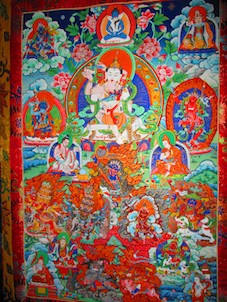
Opening the hidden countries (sbas yul) on the three borders of Kanchenjunga. Sikkim, Tibet, Nepal: Iconography, history and politics 18th-21st centuries
by Brigitte Steinmann, Professor, Institute of Sociology and Anthropology, University of Lille and CNRS (Clerse UMR 8019 and C.R.C.A.O. Paris).
Between the 17th and 19th centuries, Nepal, Sikkim and Tibet were three independent Hindu and Buddhist kingdoms that shared geographical boundaries and territories around the Kanchenjunga Massif. This sacred mountain, occupied by the Tibetan warrior gods Dzonga and Yabdud, was the scene of great religious and political events from the 17th century: the north-eastern border regions of Nepal (Walungchung gola) and north of Sikkim (Dzongu, Lachen) were marked religiously by the arrival of great gter ston and Tibetan trantrists and by the installation of royal Buddhist lineages; while the successive political events and colonial wars between Tibet, Nepal and Sikkim, between the 18th and 19th centuries, changed profoundly the political and social life of chieftaincies and local indigenous peoples, helping to chart new frontiers. modern states.In this essay on religious and political history, we rely on historical and iconographic documents, as well as on ethnographic surveys (especially between the 1980s and 2014).

